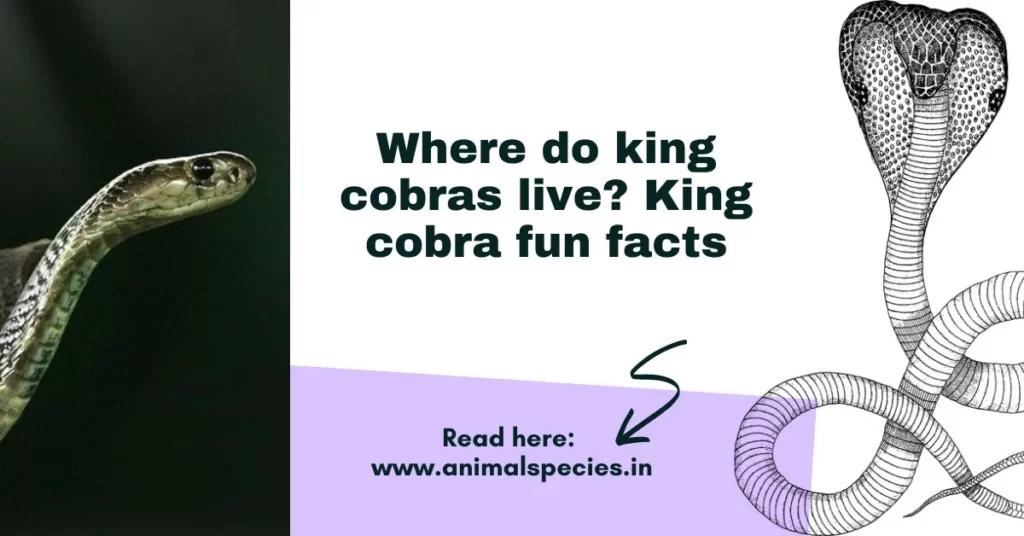Where do king cobras live: King cobra is the longest and most dangerous venomous snake in the world.
Juveniles are glossy black with narrow yellow bands. An adult snake’s head looks quite large and can be heavy, although like all snakes, it can extend its jaws to swallow large prey items.
The king cobra is a highly venomous and dangerous snake when agitated or excited that has a fearsome reputation in its range, although it is generally shy and avoids encounters with humans if possible.
The snake is a prominent symbol of mythology and folklore in India, Sri Lanka and Myanmar.
Where do king cobras live?
The king cobra is distributed throughout the Indian subcontinent, Southeast Asia and southern East Asia, Bangladesh, Bhutan, Brunei, Cambodia, China, Hong Kong, India, Indonesia, Laos, Malaysia, Myanmar, Nepal, Philippines, Singapore. Thailand, Vietnam and South China.
In India they are from Goa; Western Ghats of Karnataka, Kerala and Tamil Nadu; Eastern coastline of Andhra Pradesh and Odisha; Sundarbans Mangroves; Foothills of the Himalayas from Uttarakhand, Uttar Pradesh, Bihar, northern parts of West Bengal to most parts of the Northeast region and the Andaman Islands.
These snakes live in dense upland forests, bamboo thickets, mangrove swamps and even agricultural areas. They prefer areas with lakes and streams and can also swim in rivers.
Habits and Lifestyle:
King cobras are solitary animals and only come together to mate. like other snakes, receive chemical information through their forked tongue, which picks up scent particles and transfers them to a special sensory receptor (Jakobson’s organ) located on the roof of their mouth.
When a food scent is detected, the snake flicks its tongue to locate the prey (two forks of the tongue work in stereo); It uses its keen eyesight.
King cobras are able to detect moving prey at a distance of about 100 meters (330 ft). Their intelligence and sensitivity to earth-borne vibrations is also used to track their prey.
When disturbed, king cobras prefer to flee and avoid confrontation. However, if constantly provoked, they can become extremely aggressive. When alarmed, they throw back the front (usually one-third) of their body while extending their necks, showing the scales and hissing loudly.
While raising their body, king cobras can still move forward to strike with a long distance and people may misjudge the safe zone. This snake can give multiple bites in a single attack and adults bite and hold.
If king cobras encounter a natural predator, such as a mongoose, that has immunity to neurotoxins, these snakes will usually try to escape.
When unable to do so, they form distinctive cobra hoods and emit a hiss, sometimes striking with a false mouth.
King cobras can still proceed to strike with long distances and people may misjudge the safe zone. This snake can give multiple bites in a single attack and adults bite and hold.
If king cobras encounter a natural predator, such as a mongoose, that has immunity to neurotoxins, these snakes will usually try to escape. When unable to do so, they form distinctive cobra hoods and emit a hiss, sometimes striking with a false mouth.
King cobras can still proceed to strike with long distances and people may misjudge the safe zone. This snake can give multiple bites in a single attack and adults bite and hold.
If king cobras encounter a natural predator, such as a mongoose, that has immunity to neurotoxins, these snakes will usually try to escape. When unable to do so, they form distinctive cobra hoods and emit a hiss, sometimes striking with a false mouth.
Diet and Nutrition: King cobras are carnivores and their diet is primarily other snakes such as cobras and various members of the krait.
Mating Habits:
Mating Behavior: Monogamous
Breeding season: January-April
Incubation period: 51-79 days
Independent Age: Time of birth
FEMALE NAME: Mahila
MALE NAME: Male
Baby Name: Snake
Child bearing: 12-51 eggs
King cobras are thought to be monogamous, returning to a previous mate each breeding season. They breed from January to April. King cobra is oviparous (egg laying). Females build a nest in which they lay 12 to 51 eggs and guard it during an incubation period of about 51 to 79 days.
They are independent by birth. King cobras are unusual among snakes in that the female is an extremely devoted parent.
For the nest, the female throws leaves and other debris into a mound and stays in the nest until the young hatch. He doggedly guards the mound, rearing in a threatening display if a large animal gets too close.
Inside the mound, the eggs are incubated at a constant temperature of 28 °C (82 °F). When the eggs begin to hatch, the female leaves the nest.
A baby king cobra’s venom is just as strong as an adult’s. They are alert and nervous, highly aggressive when disturbed.
Population Threats:
King cobra populations have declined in some areas of its range due to deforestation and ongoing collection for the international pet trade.
Fun facts for kids:
The king cobra’s generic name, Ophiophagos, is a Greek word meaning “snake eater”.
After a large meal, king cobras live many months without another due to their slow metabolic rate.
Like all snakes, king cobras have flexible jaws. The jawbones are connected by flexible ligaments, which enable the lower jawbones to move freely.
A good defense for anyone who accidentally encounters a king cobra is to slowly remove a shirt or hat and drop it on the ground as you walk away.
SOURCES: wikipedia, san diego zoo

